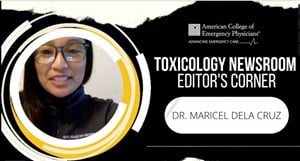
Riot Control Agents
Background
Chemical riot control agents are used all over the world. Tear gas and pepper spray are household names and the latter can be purchased for personal protection with the simple click of a button from many online retailers.4,9 From Parisian police using tear gas and pepper spray to disperse soccer fans, to Philadelphia police tear-gassing protestors, and Hong Kong law enforcement employing tear gas to disband crowds it is hard to deny the recent increase in media coverage of these riot control agents.4 In a recent conversation with a local Philadelphia Law Enforcement Officer I learned there are several types of riot or crowd control agents such as pepper ball guns (think paint-ball filled with pepper spray), gas grenades (which can be hurled or launched from extended distances), and shock rounds which are essentially a bean bag fired from stand issued firearm.6 However, for this article, I want to focus on the decontamination and treatment of chemical agents such as tear gas and pepper spray.
Pepper spray was invented in 1962 by a Pittsburgh man named Alan Littman after a colleague of his was assaulted on a walk home. Nearly four years later police forces demonstrated pepper spray to the general public as a humane method of deterring crime. United States police and military have used similar chemical irritants for a number of various tasks since then.7
Compounds
There are many different types of chemicals used by law enforcement and the military, but the most common are Chloroacetophenone (CN), Chlorobenzylidenemalonitrile(CS), Dibenzoxazepine, and Trichloronitromethane (pepper gas).1,10 These chemicals act as Lacrimators and act very quickly to subdue targets. They can be deployed as liquids, gasses, or even solids that will ‘explode’ on impact, spreading the offending agent.1,2 Most commonly they are aerosolized for use in close-quarter confrontations.
Oleoresin Capsaicin is the active compound in hot/spicy peppers and is also used in pepper spray, it is extracted and concentrated from the capsaicin annum plant.5,8,11 There are five capsaicinoid compounds that all chemically behave the same.11 Similarly to the compounds above, they are lacrimators and irritants. On a cellular level, they cause a release of calcium that causes neurotransmitter release leading to the sensation of heat, pain, irritation, and lacrimation.5,10 Capsaicin can be found in many compounds such as over-the-counter pain-relief creams.5
Lacrimators are fast-acting irritants that can cause intense pain, lacrimation, mucosal irritation, and even contact dermatitis.10,11 These injuries are usually mild and self-limiting, however, they can also be associated with inhalation injuries that can range from mild to even life-threatening.10 Patients exposed to these agents will complain of a burning sensation in the skin, eyes, nose, and mouth as well as rhinorrhea, blurry vision, difficulty swallowing, rashes, and even nausea with possible vomiting.1
Clinical Management
Care of these patients begins with immediate and thorough decontamination of the patient’s skin and eyes as well as prompt evaluation of the patient’s airway.1,2,10 According to Tintinalli’s Emergency Medicine Textbook, “the goal of treatment for chemical burns is to minimize areas of permanent damage and maximize salvageable areas.”10 Treatment goals should be targeted to symptomatic relief.
Ear, nose, and throat: Nasal mucosal irritation and rhinorrhea have instantaneous onset and will usually subside with decontamination.10,11 The patient will also complain of burning sensations in the mouth and throat that are short-lived and self-limiting, usually resolved before the patient arrives at the ED.9
Ophthalmology: Along with the above symptoms, lacrimation and ocular irritation begin immediately and will also resolve with copious decontamination.3,8 Conjunctivitis and blepharitis (inflammation of the eyelids) are very common and self-limiting.3 Due to this irritation patients can have self-inflicted corneal abrasions, and because of this, evaluation using fluorescein dye and the black light is highly recommended.3,8,10 Treatment of corneal abrasions should be routine with NSAIDs for pain control and antibiotics in ophthalmic solution.10
Pulmonary: Patients with underlying reactive airway disease can experience symptoms consistent with bronchoconstriction; in these cases, inhaled albuterol can be very useful.6,9 Patients presenting with symptoms of bronchoconstriction should be observed and re-evaluated for possible re-administration of albuterol.10
Dermatologic: Contact dermatitis, erythema, and pain are self-limiting and can be relieved with copious irrigation or cooling/hydrating creams that can be purchased over the counter.10,11
Some commercially produced riot control agents have fluorinated compounds in them which can be visualized using a standard issue black light.5
Conclusion
The use of riot control agents such as tear gas and pepper spray have been used since the early 1970s however with recent worldwide events it seems as if their use has become more common. When treating a patient who has been exposed to these compounds the treatment team must begin immediate copious irrigation. “Almost universally, earlier irrigation means a better prognosis.”10
References
- Centers for Disease Control and Prevention. (2018, April 4). Facts About Riot Control Agents, Retrieved July 6, 2022 from https://emergency.cdc.gov/agent/riotcontrol/factsheet.asp
- Centers for Disease Control and Prevention. (2011, May 12). Chloroacetophenone (CN): Riot control/tear agent. Retrieved July 6, 2022, from https://www.cdc.gov/niosh/ershdb/emergencyresponsecard_29750033.html
- Epstein, R. J., & Majmudar, P. A. (2001). Pepper spray in the eye. Ophthalmology, 108(10), 1712-3. https://doi.org/10.1016/s0161-6420(01)00732-1
- Amnesty International USA. (2020, June 11). Global use of tear gas fuels police abuses. Retrieved July 6, 2022, from https://www.amnestyusa.org/press-releases/toxic-trade-in-tear-gas-fuels-police-abuses/
- Rohrig, B. (2013, December). Hot Peppers: Muy Caliente. American Chemical Society. Retrieved July 6, 2022, from https://www.acs.org/content/acs/en/education/resources/highschool/chemmatters/past-issues/archive-2013-2014/peppers.html
- Philadelphia Police Law Enforcement Officer. Interview. Conducted by William Grill. 4 July 2022.
- Gross, D. A. (2014, November 4). The Forgotten History of Mace, Designed by a 29-Year-Old and Reinvented as a Police Weapon. Smithsonian Magazine. Retrieved July 7, 2022, from https://www.smithsonianmag.com/history/forgotten-history-mace-designed-29-year-old-and-reinvented-police-weapon-180953239/
- di Justo, P. (2013, July 9). Object of Interest: Pepper Spray. The New Yorker. http://www.newyorker.com/tech/annals-of-technology/object-of-interest-pepper-spray
- Smith, C. G., & Stopford, W. (1999). Health hazards of pepper spray. North Carolina medical journal, 60(5), 268–274. Duke University. https://fmch.duke.edu/divisions/division-occupational-environmental-medicine/duke-toxicology-program
- Tintinalli, J. E., Cydulka, R. K., & Petrini, F. (2020). Toxicology. Tintinalli's: Manual of Emergency Medicine. In A.D. Editore (Ed) (pp. 1385–1392).
- Yeung, M., & Tang, W. Y. (2015). Clinicopathological effects of pepper (oleoresin capsicum) spray. Hong Kong Medical Journal. https://doi.org/10.12809/hkmj154691
William Grill, DO



